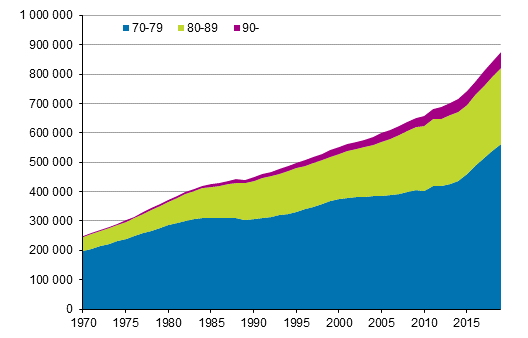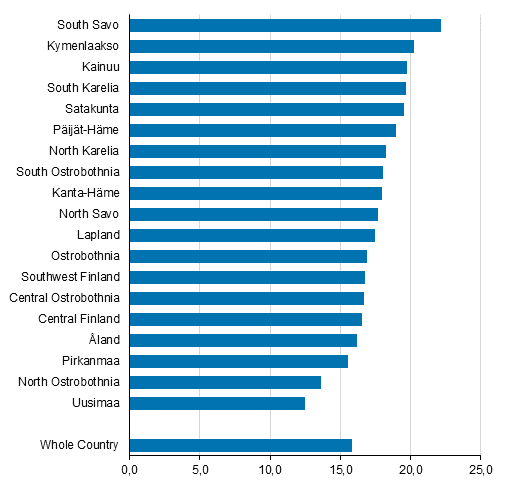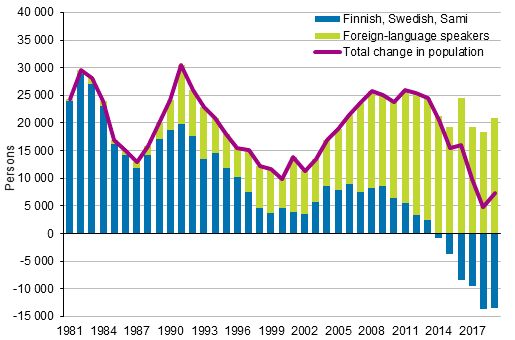Published: 24 March 2020
Number of persons aged 70 or over 874,000
According to Statistics Finland’s statistics on the population structure there were 874,314 persons aged at least 70 in Finland at the end of 2019. Of them, 370,405 were men and 503,909 women. The number of persons aged 70 or over has grown by 100,000 in three years.
Number of persons aged 70 or over in Finland in 1970 to 2019

Share of persons aged 70 or over in the population highest in South Savo
In South Savo and Kymenlaakso at least every fifth person was aged 70 or over at the end of 2019. In Kainuu, South Karelia and Satakunta nearly every fifth person was aged 70 or over. The share of persons aged 70 or over was lowest in the region of Uusimaa.
The share of persons aged 70 or over in the population was at least 30 per cent in the municipalities of Kuhmoinen, Sysmä, Puumala, Vesanto and Luhanka. The share was highest in the municipality of Kuhmoinen, 33 per cent.
Share of persons aged 70 or over by region in 2019

Population grew because of foreign-language speaking population
According to Statistics Finland's statistics on population structure, the official total population of Finland at the end of 2019 was 5,525,292. In the course of 2019, Finland’s population grew by 7,373 persons. The number of persons speaking Finnish, Swedish or Sami as their native language went down by 13,525 persons, and the number of foreign-language speakers grew by 20,898 persons.
Change in the population by native language in 1981 to 2019

Population grew in five regions, population loss in all municipalities in six regions
During 2019, the population grew in in five regions and diminished in 14 regions. In absolute numbers, the population grew most in Uusimaa, by 18,701 persons, in Pirkanmaa, by 2,571 persons, and in Southwest Finland, by 759 persons. The relative population increase in Mainland Finland was also highest in Uusimaa, 1.1 per cent. Foreign-language speakers account for 78 per cent of the population growth in the region of Uusimaa
The biggest absolute decrease in population was seen in South Savo (2,280 persons) and Kymenlaakso (2,221 persons). In relative numbers, the population also decreased most in Kymenlaakso and South Savo, by 1.6 per cent. All municipalities in South Karelia, South Savo, Kainuu, Kymenlaakso, Päijät-Häme and Satakunta lost population.
Foreign-language speakers increased the population of the Helsinki region, Kouvola lost over one thousand inhabitants for the third successive year
During 2019, the population grew in 54 and diminished in 256 municipalities. The biggest absolute increase in population was seen in Espoo, 6,099 persons, in Helsinki (5,793) and in Vantaa (5,609). Foreign-language speakers accounted for 71 per cent of the population growth in the Helsinki region.
Examined in relative terms, the population grew in Mainland Finland most in Kustavi and Vantaa (2.5 per cent) and in Sipoo and Kempele (2.4 per cent).
In absolute numbers, the population decreased most in Kouvola, by 1,064 persons, and in Kotka, by 757 persons. In Mainland Finland, the largest relative decreases in population occurred in Miehikkälä (4.3 per cent) and Jämijärvi (3.9 per cent).
Number of foreign-language speakers exceeded 400,000, over 81,000 Russian native language speakers
A total of 412,644 persons speaking a foreign language as their native language were living permanently in Finland at the end of 2019. The proportion of foreign-language speakers in the total population is seven per cent. The biggest foreign-language speaking groups were Russian speakers, 81,606 persons, Estonian speakers, 49,427, and Arabic speakers, 31,920.
Examined by region, the share of foreign-language speakers was at the end of 2019 highest in the region of Uusimaa, 14 per cent of the population, and lowest in South Ostrobothnia, two per cent. Examined by municipality, the share of foreign-language speakers among the population was highest in Vantaa, 20 per cent, in Espoo, 18 per cent, and in Helsinki, 16 per cent.
Demographic dependency ratio highest since 1922
At the end of 2019, there were 871,036 persons aged under 15 in Finland and 3,422,982 persons aged between 15 and 64. Persons aged 65 or over numbered 1,231,274 at the end of 2019. The demographic dependency ratio, or the number of those aged 15 or under and 65 or over per 100 working age persons, was 61.4.
The demographic dependency ratio has been last higher than this in 1922. During our independence, the demographic dependency ratio was at its highest in 1917 (67.6) and at its lowest in 1984 (46.7).
Source: Population Structure 2019, Statistics Finland
Inquiries: Markus Rapo 029 551 3238, info@stat.fi
Director in charge: Jari Tarkoma
Publication in pdf-format (339.3 kB)
- Tables
-
Tables in databases
Pick the data you need into tables, view the data as graphs, or download the data for your use.
Appendix tables
- Figures
- Quality descriptions
-
- Quality description: Population structure 2019 (24.3.2020)
Updated 24.03.2020
Official Statistics of Finland (OSF):
Population structure [e-publication].
ISSN=1797-5395. 2019. Helsinki: Statistics Finland [referred: 19.4.2025].
Access method: http://stat.fi/til/vaerak/2019/vaerak_2019_2020-03-24_tie_001_en.html

